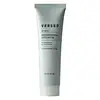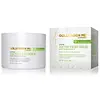What's inside
What's inside
 Key Ingredients
Key Ingredients

 Benefits
Benefits

 Concerns
Concerns

 Ingredients Side-by-side
Ingredients Side-by-side

Water
Skin ConditioningMicrocrystalline Cellulose
AbsorbentHelianthus Annuus Seed Oil
EmollientCetyl Alcohol
EmollientSimmondsia Chinensis Seed Oil
EmollientGlycerin
HumectantGlyceryl Stearate
EmollientCandelilla/Jojoba/Rice Bran Polyglyceryl-3 Esters
EmulsifyingRibes Nigrum Leaf Extract
PerfumingRubus Idaeus Leaf Extract
Skin ConditioningCymbopogon Citratus Leaf Oil
MaskingMoringa Oleifera Seed Oil
EmollientArginine
MaskingHydroxyacetophenone
AntioxidantXanthan Gum
EmulsifyingCetearyl Alcohol
EmollientSodium Stearoyl Lactylate
EmulsifyingLauryl Glucoside
CleansingPhenoxyethanol
PreservativeEthylhexylglycerin
Skin ConditioningSorbic Acid
PreservativeCitral
PerfumingWater, Microcrystalline Cellulose, Helianthus Annuus Seed Oil, Cetyl Alcohol, Simmondsia Chinensis Seed Oil, Glycerin, Glyceryl Stearate, Candelilla/Jojoba/Rice Bran Polyglyceryl-3 Esters, Ribes Nigrum Leaf Extract, Rubus Idaeus Leaf Extract, Cymbopogon Citratus Leaf Oil, Moringa Oleifera Seed Oil, Arginine, Hydroxyacetophenone, Xanthan Gum, Cetearyl Alcohol, Sodium Stearoyl Lactylate, Lauryl Glucoside, Phenoxyethanol, Ethylhexylglycerin, Sorbic Acid, Citral
Water
Skin ConditioningCrystallins
Skin ConditioningSimmondsia Chinensis Seed Oil
EmollientCetyl Alcohol
EmollientCandelilla/Jojoba/Rice Bran Polyglyceryl-3 Esters
EmulsifyingGlyceryl Stearate
EmollientGlycerin
HumectantSodium Hyaluronate
HumectantSqualane
EmollientCetearyl Alcohol
EmollientMagnesium Aluminum Silicate
AbsorbentSodium Stearoyl Lactylate
EmulsifyingGlyceryl Caprylate
EmollientXanthan Gum
EmulsifyingPhenoxyethanol
PreservativeCellulose Gum
Emulsion StabilisingEthylhexylglycerin
Skin ConditioningChondrus Crispus Extract
Skin ConditioningCitrus Paradisi Peel Oil
MaskingAspalathus Linearis Leaf Extract
Skin ConditioningWater, Crystallins, Simmondsia Chinensis Seed Oil, Cetyl Alcohol, Candelilla/Jojoba/Rice Bran Polyglyceryl-3 Esters, Glyceryl Stearate, Glycerin, Sodium Hyaluronate, Squalane, Cetearyl Alcohol, Magnesium Aluminum Silicate, Sodium Stearoyl Lactylate, Glyceryl Caprylate, Xanthan Gum, Phenoxyethanol, Cellulose Gum, Ethylhexylglycerin, Chondrus Crispus Extract, Citrus Paradisi Peel Oil, Aspalathus Linearis Leaf Extract
Ingredients Explained
These ingredients are found in both products.
Ingredients higher up in an ingredient list are typically present in a larger amount.
Candelilla/Jojoba/Rice Bran Polyglyceryl-3 Esters isn't fungal acne safe.
Cetearyl alcohol is a mixture of two fatty alcohols: cetyl alcohol and stearyl alcohol. It is mainly used as an emulsifier. Emulsifiers help prevent the separation of oils and products. Due to its composition, it can also be used to thicken a product or help create foam.
Cetearyl alcohol is an emollient. Emollients help soothe and hydrate the skin by trapping moisture.
Studies show Cetearyl alcohol is non-toxic and non-irritating. The FDA allows products labeled "alcohol-free" to have fatty alcohols.
This ingredient is usually derived from plant oils such as palm, vegetable, or coconut oils. There is debate on whether this ingredient will cause acne.
Due to the fatty acid base, this ingredient may not be Malassezia folliculitis safe.
Learn more about Cetearyl AlcoholCetyl Alcohol is a fatty alcohol. Fatty Alcohols are most often used as an emollient or to thicken a product.
Its main roles are:
Though it has "alcohol" in the name, it is not related to denatured alcohol or ethyl alcohol.
The FDA allows products labeled "alcohol-free" to have fatty alcohols.
Learn more about Cetyl AlcoholEthylhexylglycerin (we can't pronounce this either) is commonly used as a preservative and skin softener. It is derived from glyceryl.
You might see Ethylhexylglycerin often paired with other preservatives such as phenoxyethanol. Ethylhexylglycerin has been found to increase the effectiveness of these other preservatives.
Glycerin is already naturally found in your skin. It helps moisturize and protect your skin.
A study from 2016 found glycerin to be more effective as a humectant than AHAs and hyaluronic acid.
As a humectant, it helps the skin stay hydrated by pulling moisture to your skin. The low molecular weight of glycerin allows it to pull moisture into the deeper layers of your skin.
Hydrated skin improves your skin barrier; Your skin barrier helps protect against irritants and bacteria.
Glycerin has also been found to have antimicrobial and antiviral properties. Due to these properties, glycerin is often used in wound and burn treatments.
In cosmetics, glycerin is usually derived from plants such as soybean or palm. However, it can also be sourced from animals, such as tallow or animal fat.
This ingredient is organic, colorless, odorless, and non-toxic.
Glycerin is the name for this ingredient in American English. British English uses Glycerol/Glycerine.
Learn more about GlycerinGlyceryl Stearate is a mix of glycerin and stearic acid.
It is used to stabilize the mixing of water and oil ingredients. By preventing these ingredients from separating, it can help elongate shelf life. It can also help thicken the product's texture.
As an emollient, it helps soften skin and supports barrier-replenishing ingredients.
In cosmetics, Glyceryl Stearate is often made from vegetable oils or synthetically produced.
This ingredient may not be fungal-acne safe
Fun fact: The human body also creates Glyceryl Stearate naturally.
Learn more about Glyceryl StearatePhenoxyethanol is a preservative that has germicide, antimicrobial, and aromatic properties. Studies show that phenoxyethanol can prevent microbial growth. By itself, it has a scent that is similar to that of a rose.
It's often used in formulations along with Caprylyl Glycol to preserve the shelf life of products.
This oil comes from the seeds of the desert shrub called Jojoba. It is more commonly known as jojoba oil, a non-comedogenic oil.
Jojoba oil does not contain fragrance and has many fatty-acids, making it a great soothing ingredient.
It also contains Vitamin E, a great moisturizing ingredient. Vitamin E is also an antioxidant and protects your skin against oxidative damage.
This ingredient humectant properties, meaning it helps draw moisture from the air. This helps keep your skin hydrated.
While jojoba has antibacterial properties, it is only able to kill some strains of bacteria.
Studies also show it helps in wound healing. In fact, Indigenous cultures have used jojoba as a moisturizer and to help treat burns for centuries.
Fun fact: Jojoba oil similar to natural human skin sebum, so it has a great effect on dry skin. It is also promising with helping to regulate sebum production.
Due to its fatty acid content, Jojoba oil may not be fungal acne safe. We recommend speaking with a professional if you have any concerns.
Learn more about Simmondsia Chinensis Seed OilThis ingredient also goes by the name SSL. It is a non-toxic, biodegradable ingredient made from renewable sources.
SSL is typically used as a surfactant and emulsifier in skincare to stabilize water-based formulas and improve texture. It can be synthetic or animal-derived.
Water. It's the most common cosmetic ingredient of all. You'll usually see it at the top of ingredient lists, meaning that it makes up the largest part of the product.
So why is it so popular? Water most often acts as a solvent - this means that it helps dissolve other ingredients into the formulation.
You'll also recognize water as that liquid we all need to stay alive. If you see this, drink a glass of water. Stay hydrated!
Learn more about WaterXanthan gum is used as a stabilizer and thickener within cosmetic products. It helps give products a sticky, thick feeling - preventing them from being too runny.
On the technical side of things, xanthan gum is a polysaccharide - a combination consisting of multiple sugar molecules bonded together.
Xanthan gum is a pretty common and great ingredient. It is a natural, non-toxic, non-irritating ingredient that is also commonly used in food products.
Learn more about Xanthan Gum